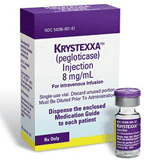 |
| Horizon CEO Tim Walbert |
The gout drug Krystexxa has struggled under a couple of different owners in the past few years, and now, with Crealta's December agreement to sell itself to Horizon Pharma ($HZNP), it's changing hands again. But its new owners think they can ramp up peak sales significantly--and they're working on multiple strategies to help it get there.
As Horizon CEO Tim Walbert told FiercePharma during the J.P. Morgan Healthcare Conference earlier this month, the first step is to pick up where Crealta left off. Original owner Savient saw the med as a treatment for the 3 million diagnosed gout patients--and priced it accordingly. But Crealta zeroed in on a subset of the refractory gout population in the U.S.--totaling about 50,000 patients--in which the drug works best. And at that point, it hiked the price by two and a half or three times its per-vial price of what Walbert figures was $5,000 or $6,000.
The higher price alone won't get Krystexxa to where the Illinois pharma wants it to be, though; it's also beefing up its commercial efforts across the board. Horizon's 40-person rheumatology sales force will promote Krystexxa alongside corticosteroid Rayos, with a goal "for that organization to call on a much broader range of rheumatologists," ID the right patients for the therapy, and help educate doctors on its safety and efficacy, Walbert said. After they've done that, key account managers--who know the reimbursement dynamics of the rheumatology marketplace and are "deep in science"--will help secure reimbursement for the pricey therapy and teach physicians' offices how to administer it.

Those key account managers now number 24, building on Crealta's tally of 15 or 16, Walbert said. And on top of that, Horizon is also fielding 10 medical liaisons, bringing its total tally of promoters over 60--quadruple where it was before.
The final pieces of the puzzle? Horizon has accelerated plans for a clinical trial to test a new dosing schedule, hoping the new approach will cut down on side effects and improve response.
All things considered, Horizon thinks it can take peak sales up to $250 million per year, which would certainly mark a dramatic turnaround. After Savient snagged a long-awaited FDA approval in September of 2010, Krystexxa churned out only $1.4 million in the first half of 2011; by year's end, the company was grappling with $102 million in losses on just $3.1 million in revenue. Layoffs and cost-cutting efforts couldn't right the ship, forcing Savient to file bankruptcy in October 2013.
Meanwhile, there's a new product on the scene from AstraZeneca ($AZN) designed to reduce the high levels of uric acid in the blood that cause gout in the first place. In December, the FDA green-lighted the British pharma giant's Zurampic, though it includes a boxed warning concerning acute kidney failure.
Special Report: 10 top drug launch disasters - Savient - Krystexxa